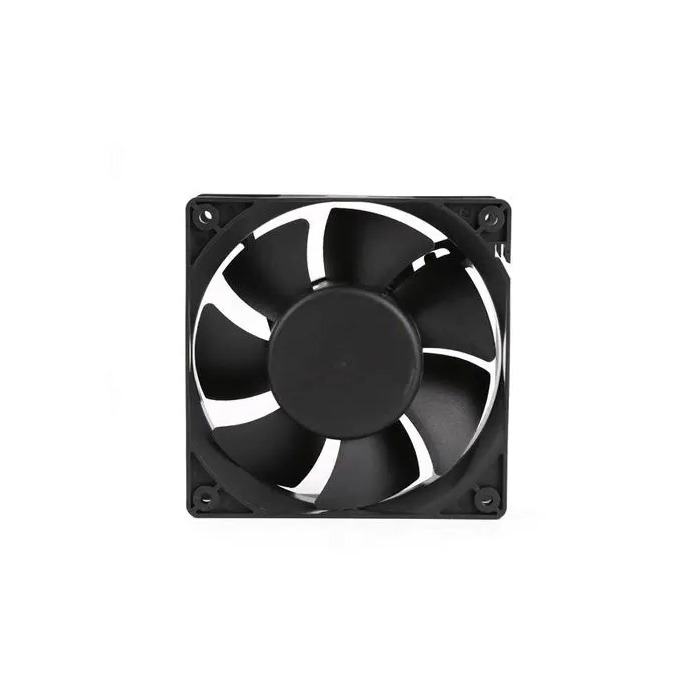Choosing a cooling fan size requires a number of factors to be considered, including the power of the fan, the airflow, and the amount of heat generated by the device. Airflow is the speed and volume of air flowing through the fan blades, while air pressure is the pressure created by pushing air through the blades. The larger the fan size, the greater the airflow will usually be, but at the same time the lower the air pressure. Conversely, the smaller the fan size, the higher the air pressure but the lower the airflow.
There are many factors to consider when sizing a cooling fan, including:
Equipment heat: Fan size needs to be selected based on the heat generated by the equipment. For example, a 1916667CFM airflow is required on a computer, and a 12250CFM airflow is required on a DC switching power supply.
Fan power: the higher the fan power, the fan size needs to be increased accordingly.

Equipment volume: the fan size needs to match the equipment volume to ensure that the fan can effectively dissipate heat.
Quietness: If quietness is required, a smaller fan size is needed.
Mountable size: The fan size needs to match the mountable size of the device.
When choosing the cooling fan size, you need to choose the right number of inches according to the actual needs and the use of the environment. For example, common sizes are 60, 70, 80, 92, 120 and other mm, and larger or smaller sizes are also available.
In actual application, it needs to be tested and adjusted according to the equipment and environmental conditions. For example, fan and radiator sizes need to be matched to ensure the best use.
In conclusion, the selection of cooling fan size needs to take into account factors such as the heat generated by the equipment, fan power, equipment volume, silence requirements and mountable size, etc., to ensure that the fan can effectively dissipate heat, while meeting the silence requirements and mountable size and other requirements.
Title: The Importance of High-Efficiency Cooling Fans in Server Rooms Introduction Server rooms are an integral part of modern-day businesses, housing crucial data and applications that drive operations. The equipment within these rooms, such as servers, storage units, and networking devices, generate significant heat due to their constant use. This heat can lead to overheating, causing critical failures and affecting the overall performance of the devices. Therefore, it is crucial to maintain a suitabl...
Title: The Influence of Blade Design of Cooling Fan on Airflow and Air Volume Introduction: The cooling fan is an essential component in many industrial and domestic applications, such as air conditioning, refrigeration, and computer systems. The primary function of a cooling fan is to circulate air and maintain the desired temperature in the system. The blade design of the cooling fan plays a crucial role in determining its efficiency and performance. In this article, we will discuss the influence of ...
Title: Stability Requirements for Cooling Fans in Medical Equipment In the realm of medical equipment, stability is crucial. It ensures optimal performance, prevents any malfunctions, and ultimately safeguards patient lives. One of the key components that contribute to stability is the cooling fan. These fans are responsible for keeping the equipment at optimal temperatures, preventing overheating and ensuring smooth operation. As such, it's important to understand the stability requirements for cooling ...
The choice of cooling fan material can greatly affect its thermal performance. Common cooling fan materials include plastic, metal, alloy, ceramic and nanocomposite. Cooling fans made of different materials differ in thermal performance, durability, weight and cost.First of all, cooling fans made of plastic have the advantage of low production cost, but they are less tough and vulnerable to damage, so they may have problems when used in high-temperature environments. Cooling fans made of metals and alloys...
Centrifugal fans are an air-powered mechanical device widely used in a variety of industrial facilities. The following is a common application method, which enables centrifugal fans to realize automation control, improve work efficiency and reduce the risk of human misoperation.First of all, the automation control system of centrifugal fans can be realized through remote monitoring and commanding, on-site monitoring and control, data acquisition and detection. Through these ways, the running status of the...
Title: The Importance of High-Efficiency Cooling Fans in Server Rooms Introduction Server rooms are an integral part of modern-day businesses, housing crucial data and applications that drive operations. The equipment within these rooms, such as servers, storage units, and networking devices, generate significant heat due to their constant use. This heat can lead to overheating, causing critical failures and affecting the overall performance of the devices. Therefore, it is crucial to maintain a suitabl...
Cooling fans are a widely used device in many production areas to help reduce the heat generated by machinery and equipment and to dissipate heat. For personal computers and automobiles, cooling fans are indispensable. In this article, we will explain how cooling fans work and why they are critical to the safety and performance of electrical equipment.Cooling fans work by moving air to remove the heat generated by the equipment. As the fan rotates, it creates a stream of air that removes heat from the equ...
Cooling fan noise control methods can be divided into the following aspects:1. Fan design optimization: choose the right type of fan blade, such as large-size, low-speed fans. Compared with small-sized, high-rpm fans, these types of fans are not only quieter, but also more efficient.2. Reduce the effect of fan imbalance: fan imbalance can lead to strong vibration and noise, and can be reduced by using high-quality fan materials and superb processing technology.3. Adopt noise-reducing cover: Noise-reducing...